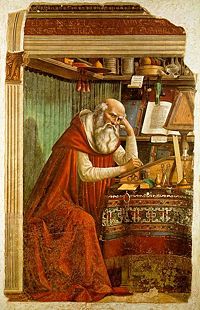Jerome
| Saint Jerome | |
|---|---|
Saint Jerome by Domenico Ghirlandaio | |
| Priest, Confessor, and Doctor of the Church | |
| Born | Born::347 AD, Stridon, Dalmatia |
| Died | Died::September 30, 420, Bethlehem, Judea |
| Venerated in | Roman Catholicism Eastern Orthodoxy Oriental Orthodoxy Anglicanism Lutheranism |
| Major shrine | Basilica di Santa Maria Maggiore, Rome, Italy |
| Feast | September 30 (Western Christianity) June 15 (Eastern Christianity) |
| Attributes | lion, cardinal attire, cross, skull, trumpet, owl, books, and writing material |
| Patronage | archaeologists, archivists, Bible scholars, librarians, libraries, schoolchildren, students, translators |
Saint Jerome (Latin: Eusebius Sophronius Hieronymus; Greek: Ευσέβιος Σωφρόνιος Ιερόνυμος, Eusēbios Sophrōnios Hierōnymos) (c. 347–Died::September 30, 420) is best known as the translator of the Bible from Greek and Hebrew into Latin. Jerome's edition, the Vulgate, is still the offical biblical text of the Roman Catholic Church. He is recognized by the Roman Catholic Church as a Saint and Doctor of the Church.
In the artistic tradition of the Roman Catholic Church it has been usual to represent him, the patron of theological learning, as a cardinal, by the side of the Bishop Augustine, the Archbishop Ambrose, and the Pope Gregory I. Even when he is depicted as a half-clad anchorite, with cross, skull, and Bible for the only furniture of his cell, the red hat or some other indication of his rank is as a rule introduced somewhere in the picture.
Works
- Letters
- The Perpetual Virginity of Blessed Mary
- To Pammachius Against John of Jerusalem
- The Dialogue Against the Luciferians
- The Life of Malchus, the Captive Monk
- The Life of Saint Hilarion
- The Life of Paulus the First Hermit
- Against Jovinianus
- Against Vigilantius
- Against the Pelagians
- Prefaces
- De Viris Illustribus (Illustrious Men)
- Apology for himself against the Books of Rufinus
See Also
References

